A Novel Technique for Designing High Power Semiconductor Optical Amplifier (SOA)-Based Tunable Fiber Compound-Ring Lasers Using Low Power Optical Components
Abstract
:1. Introduction
2. Experimental Setup
3. Principal of Operation
4. Characterization of the Fiber Compound-Ring Lasers
4.1. Gain Medium
4.2. Lasing Threshold Level
4.3. Tunable Optical Filter
4.4. Coherent Beam Combining Efficiency
4.5. Fiber Laser Power Tunability and its Switchable Dual-Output Port Operation
4.6. Wavelength Tunability
4.7. Optical Signal-To-Noise Ratio
4.8. Short-Term Optical Power
5. (N >> 1) SOA-Based Fiber Compound-Ring Laser Structure
6. Conclusions
Acknowledgments
Author Contributions
Conflicts of Interest
References
- He, X.; Fang, X.; Liao, C.; Wang, D.N.; Sun, J. A tunable and switchable single-longitudinal-mode dual-wavelength fiber laser with a simple linear cavity. Opt. Express 2009, 17, 21773–21781. [Google Scholar] [CrossRef] [PubMed]
- Barnsley, P.; Urquhart, P.; Millar, C.; Brierley, M. Fiber Fox–Smith resonators: Application to single-longitudinal-mode operation of fiber lasers. J. Opt. Soc. Am. A 1988, 5, 1339–1346. [Google Scholar] [CrossRef]
- Iwatsuki, K.; Takada, A.; Hagimoto, K.; Saruwatari, M.; Kimura, Y.; Shimizu, M. Er3+-doped Fiber-Ring-Laser with less than 10 kHz Linewidth. In Proceedings of the Optical Fiber Communication Conference, Houston, TX, USA, 6 February 1989. [Google Scholar]
- Zhang, J.; Yue, C.Y.; Schinn, G.W.; Clements, W.R.L.; Lit, J.W.Y. Stable single-mode compound-ring erbium-doped fiber laser. J. Lightwave Technol. 1996, 14, 104–109. [Google Scholar] [CrossRef]
- Chen, X.; Yao, J.; Deng, Z. Ultranarrow dual-transmission-band fiber Bragg grating filter and its application in a dual-wavelength single-longitudinal-mode fiber ring laser. Opt. Lett. 2005, 30, 2068–2070. [Google Scholar] [CrossRef] [PubMed]
- Zhang, J.; Lit, J.W.Y. Compound fiber ring resonator: Theory. J. Opt. Soc. Am. A 1994, 11, 1867–1873. [Google Scholar] [CrossRef]
- Urquhart, P. Compound optical-fiber-based resonators. J. Opt. Soc. Am. A 1988, 5, 803–812. [Google Scholar] [CrossRef]
- Zhang, J.; Lit, J.W.Y. All-fiber compound ring resonator with a ring filter. J. Lightwave Technol. 1994, 12, 1256–1262. [Google Scholar]
- Capmany, J.; Muriel, M.A. A new transfer matrix formalism for the analysis of fiber ring resonators: Compound coupled structures for FDMA demultiplexing. J. Lightwave Technol. 1990, 8, 1904–1919. [Google Scholar] [CrossRef]
- Shi, W.; Fang, Q.; Zhu, X.; Norwood, R.A.; Peyghambarian, N. Fiber lasers and their applications [Invited]. Appl. Opt. 2014, 53, 6554–6568. [Google Scholar] [CrossRef] [PubMed]
- Syms, R.R.A.; Zou, H.; Stagg, J.; Veladi, H. Sliding-blade MEMS iris and variable optical attenuator. J. Micromech. Microeng. 2004, 14, 1700. [Google Scholar] [CrossRef]
- Unamuno, A.; Uttamchandani, D. MEMS variable optical attenuator with Vernier latching mechanism. IEEE Photonics Technol. Lett. 2006, 18, 88–90. [Google Scholar] [CrossRef]
- Marxer, C.; Griss, P.; de Rooij, N.F. A variable optical attenuator based on silicon micromechanics. IEEE Photonics Technol. Lett. 1999, 11, 233–235. [Google Scholar] [CrossRef]
- Li, Q.; Au, A.A.; Lin, C.-H.; Lyons, E.R.; Lee, H.P. An efficient all-fiber variable optical attenuator via acoustooptic mode coupling. IEEE Photonics Technol. Lett. 2002, 14, 1563–1565. [Google Scholar]
- Duduś, A.; Blue, R.; Zagnoni, M.; Stewart, G.; Uttamchandani, D. Modeling and Characterization of an Electrowetting-Based Single-Mode Fiber Variable Optical Attenuator. IEEE J. Sel. Top. Quantum Electron. 2015, 21, 253–261. [Google Scholar] [CrossRef]
- Benner, A.; Presby, H.M.; Amitay, N. Low-reflectivity in-line variable attenuator utilizing optical fiber tapers. J. Lightwave Technol. 1990, 8, 7–10. [Google Scholar] [CrossRef]
- Kerbage, C.; Hale, A.; Yablon, A.; Windeler, R.S.; Eggleton, B.J. Integrated all-fiber variable attenuator based on hybrid microstructure fiber. Appl. Phys. Lett. 2001, 79, 3191–3193. [Google Scholar] [CrossRef]
- Lim, K.S.; Pua, C.H.; Harun, S.W.; Ahmad, H. Temperature-sensitive dual-segment polarization maintaining fiber Sagnac loop mirror. Opt. Laser Technol. 2010, 42, 377–381. [Google Scholar] [CrossRef]
- Sun, G.; Moon, D.S.; Chung, Y. Simultaneous Temperature and Strain Measurement Using Two Types of High-Birefringence Fibers in Sagnac Loop Mirror. IEEE Photonics Technol. Lett. 2007, 19, 2027–2029. [Google Scholar] [CrossRef]
- Fu, H.Y.; Tam, H.Y.; Shao, L.-Y.; Dong, X.; Wai, P.K.A.; Lu, C.; Khijwania, S.K. Pressure sensor realized with polarization-maintaining photonic crystal fiber-based Sagnac interferometer. Appl. Opt. 2008, 47, 2835–2839. [Google Scholar] [CrossRef] [PubMed]
- Das, G.; Lit, J.W.Y. Wavelength switching of a fiber laser with a Sagnac loop reflector. IEEE Photonics Technol. Lett. 2004, 16, 60–62. [Google Scholar] [CrossRef]
- Lim, D.S.; Lee, H.K.; Kim, K.H.; Kang, S.B.; Ahn, J.T.; Jeon, M.Y. Generation of multiorder Stokes and anti-Stokes lines in a Brillouin erbium-fiber laser with a Sagnac loop mirror. Opt. Lett. 1998, 23, 1671–1673. [Google Scholar] [CrossRef] [PubMed]
- Wang, S.S.; Hu, Z.F.; Li, Y.H.; Tong, L.M. All-fiber Fabry–Perot resonators based on microfiber Sagnac loop mirrors. Opt. Lett. 2009, 34, 253–255. [Google Scholar] [CrossRef] [PubMed]
- Ummy, M.A.; Madamopoulos, N.; Lama, P.; Dorsinville, R. Dual Sagnac loop mirror SOA-based widely tunable dual-output port fiber laser. Opt. Express 2009, 17, 14495–14501. [Google Scholar] [CrossRef] [PubMed]
- Ummy, M.A.; Madamopoulos, N.; Joyo, A.; Kouar, M.; Dorsinville, R. Tunable multi-wavelength SOA based linear cavity dual-output port fiber laser using Lyot-Sagnac loop mirror. Opt. Express 2011, 19, 3202–3211. [Google Scholar] [CrossRef] [PubMed]
- Mortimore, D.B. Fiber loop reflectors. J. Lightwave Technol. 1988, 6, 1217–1224. [Google Scholar] [CrossRef]
- Feng, S.; Mao, Q.; Shang, L.; Lit, J.W. Reflectivity characteristics of the fiber loop mirror with a polarization controller. Opt. Commun. 2007, 277, 322–328. [Google Scholar] [CrossRef]
- Klingebiel, S.; Röser, F.; Ortaç, B.; Limpert, J.; Tünnermann, A. Spectral beam combining of Yb-doped fiber lasers with high efficiency. J. Opt. Soc. Am. B 2007, 24, 1716–1720. [Google Scholar] [CrossRef]
- Raab, V.; Menzel, R. External resonator design for high-power laser diodes that yields 400 mW of TEM00 power. Opt. Lett. 2002, 27, 167–169. [Google Scholar] [CrossRef] [PubMed]
- Corcoran, C.J.; Rediker, R.H. Operation of five individual diode lasers as a coherent ensemble by fiber coupling into an external cavity. Appl. Phys. Lett. 1991, 59, 759–761. [Google Scholar] [CrossRef]
- Liu, B.; Braiman, Y. Coherent beam combining of high power broad-area laser diode array with near diffraction limited beam quality and high power conversion efficiency. Opt. Express 2013, 21, 31218–31228. [Google Scholar] [CrossRef] [PubMed]
- Daneu, V.; Sanchez, A.; Fan, T.Y.; Choi, H.K.; Turner, G.W.; Cook, C.C. Spectral beam combining of a broad-stripe diode laser array in an external cavity. Opt. Lett. 2000, 25, 405–407. [Google Scholar] [CrossRef] [PubMed]
- Loftus, T.H.; Liu, A.; Hoffman, P.R.; Thomas, A.M.; Norsen, M.; Royse, R.; Honea, E. 522 W average power, spectrally beam-combined fiber laser with near-diffraction-limited beam quality. Opt. Lett. 2007, 32, 349–351. [Google Scholar] [CrossRef] [PubMed]
- Fan, T.Y. Laser beam combining for high-power, high-radiance sources. IEEE J. Sel. Top. Quantum Electron. 2005, 11, 567–577. [Google Scholar] [CrossRef]
- Augst, S.J.; Goyal, A.K.; Aggarwal, R.L.; Fan, T.Y.; Sanchez, A. Wavelength beam combining of ytterbium fiber lasers. Opt. Lett. 2003, 28, 331–333. [Google Scholar] [CrossRef] [PubMed]
- Wirth, C.; Schmidt, O.; Tsybin, I.; Schreiber, T.; Peschel, T.; Brückner, F.; Clausnitzer, T.; Limpert, J.; Eberhardt, R.; Tünnermann, A.; et al. 2 kW incoherent beam combining of four narrow-linewidth photonic crystal fiber amplifiers. Opt. Express 2009, 17, 1178–1183. [Google Scholar] [CrossRef] [PubMed]
- Sprangle, P.; Ting, A.; Penano, J.; Fischer, R.; Hafizi, B. Incoherent Combining and Atmospheric Propagation of High-Power Fiber Lasers for Directed-Energy Applications. IEEE J. Quantum Electron. 2009, 45, 138–148. [Google Scholar] [CrossRef]
- Sabourdy, D.; Kermène, V.; Desfarges-Berthelemot, A.; Vampouille, M.; Barthélémy, A. Coherent combining of two Nd: YAG lasers in a Vernier–Michelson-type cavity. Appl. Phys. B 2002, 75, 503–507. [Google Scholar] [CrossRef]
- Bloom, G.; Larat, C.; Lallier, E.; Carras, M.; Marcadet, X. Coherent combining of two quantum-cascade lasers in a Michelson cavity. Opt. Lett. 2010, 35, 1917–1919. [Google Scholar] [CrossRef] [PubMed]
- Sabourdy, D.; Kermène, V.; Desfarges-Berthelemot, A.; Lefort, L.; Barthélémy, A.; Even, P.; Pureur, D. Efficient coherent combining of widely tunable fiber lasers. Opt. Express 2003, 11, 87–97. [Google Scholar] [CrossRef] [PubMed]
- Jeux, F.; Desfarges-Berthelemot, A.; Kermène, V.; Barthelemy, A. Experimental demonstration of passive coherent combining of fiber lasers by phase contrast filtering. Opt. Express 2012, 20, 28941–28946. [Google Scholar] [CrossRef] [PubMed]
- Kozlov, V.A.; Hernández-Cordero, J.; Morse, T.F. All-fiber coherent beam combining of fiber lasers. Opt. Lett. 1999, 24, 1814–1816. [Google Scholar] [CrossRef] [PubMed]
- Moon, D.S.; Kim, B.H.; Lin, A.; Sun, G.; Han, W.T.; Han, Y.G.; Chung, Y. Tunable multi-wavelength SOA fiber laser based on a Sagnac loop mirror using an elliptical core side-hole fiber. Opt. Express 2007, 15, 8371–8376. [Google Scholar] [CrossRef] [PubMed]
- Kim, C.S.; Sova, R.M.; Kang, J.U. Tunable multi-wavelength all-fiber Raman source using fiber Sagnac loop filter. Opt. Commun. 2003, 218, 291–295. [Google Scholar] [CrossRef]
- Zverev, P.G.; Basiev, T.T.; Prokhorov, A.M. Stimulated Raman scattering of laser radiation in Raman crystals. Opt. Mater. 1999, 11, 335–352. [Google Scholar] [CrossRef]
- Smith, S.P.; Zarinetchi, F.; Ezekiel, S. Narrow-linewidth stimulated Brillouin fiber laser and applications. Opt. Lett. 1991, 16, 393–395. [Google Scholar] [CrossRef] [PubMed]
- Yong, J.C.; Thévenaz, L.; Kim, B.Y. Brillouin Fiber Laser Pumped by a DFB Laser Diode. J. Lightwave Technol. 2003, 21, 546. [Google Scholar] [CrossRef]
- Lowery, A.J.; Premaratne, M. Design and simulation of a simple laser rangefinder using a semiconductor optical amplifier-detector. Opt. Express 2005, 13, 3647–3652. [Google Scholar] [CrossRef] [PubMed]
- Lowery, A.J.; Premaratne, M. Reduced component count optical delay discriminator using a semiconductor optical amplifier-detector. Opt. Express 2005, 13, 290–295. [Google Scholar] [CrossRef] [PubMed]
- Premaratne, M.; Lowery, A.J. Analytical characterization of SOA-based optical pulse delay discriminator. J. Lightwave Technol. 2005, 23, 2778–2787. [Google Scholar] [CrossRef]
- Arez, N.; Razaghi, M. Optical and logic gate implementation using four wave mixing in semiconductor optical amplifier for high speed optical communication systems. In Proceedings of the International Conference on Network and Electronics Engineering, Singapore, 16–18 September 2011; pp. 65–70. [Google Scholar]
- Das, N.; Razaghi, M.; Hosseini, R. Four-wave mixing in semiconductor optical amplifiers for high-speed communications. In Proceedings of the 5th International Conference on Computers and Devices for Communication (CODEC), Kolkata, India, 17–19 December 2012. [Google Scholar]
- Das, N.K.; Yamayoshi, Y.; Kawaguchi, H. Analysis of basic four-wave mixing characteristics in a semiconductor optical amplifier by the finite-difference beam propagation method. IEEE J. Quantum Electron. 2000, 36, 1184–1192. [Google Scholar]
- Sato, K.; Toba, H. Reduction of mode partition noise by using semiconductor optical amplifiers. IEEE J. Sel. Top. Quantum Electron. 2001, 7, 328–333. [Google Scholar] [CrossRef]
- Takano, K.; Nakagawa, K.; Takahashi, Y.; Ito, H. Reduction of Power Fluctuation in Pulsed Lightwave Frequency Sweepers with SOA Following EDFA. IEEE Photonics Technol. Lett. 2007, 19, 525–527. [Google Scholar] [CrossRef]
- Bruesselbach, H.; Jones, D.C.; Mangir, M.S.; Minden, M.; Rogers, J.L. Self-organized coherence in fiber laser arrays. Opt. Lett. 2005, 30, 1339–1341. [Google Scholar] [CrossRef] [PubMed]
- Lhermite, J.; Desfarges-Berthelemot, A.; Kermene, V.; Barthelemy, A. Passive phase locking of an array of four fiber amplifiers by an all-optical feedback loop. Opt. Lett. 2007, 32, 1842–1844. [Google Scholar] [CrossRef] [PubMed]
- Lei, B.; Feng, Y. Phase locking of an array of three fiber lasers by an all-fiber coupling loop. Opt. Express 2007, 15, 17114–17119. [Google Scholar] [CrossRef] [PubMed]
- Ummy, M.A.; Bikorimana, S.; Madamopoulos, N.; Dorsinville, R. Beam Combining of SOA-Based Bidirectional Tunable Fiber Nested Ring Lasers With Continuous Tunability Over the C-band at Room Temperature. J. Lightwave Technol. 2016, 34, 3703–3710. [Google Scholar] [CrossRef]
- Cariou, J.P.; Augere, B.; Valla, M. Laser source requirements for coherent lidars based on fiber technology. C. R. Phys. 2006, 7, 213–223. [Google Scholar] [CrossRef]
- Martinez-Ríos, A.; Anzueto-Sanchez, G.; Selvas-Aguilar, R.; Guzman, A.A.C.; Toral-Acosta, D.; Guzman-Ramos, V.; Duran-Ramirez, V.M.; Guerrero-Viramontes, J.A.; Calles-Arriaga, C.A. High sensitivity fiber laser temperature sensor. IEEE Sens. J. 2015, 5, 2399–2402. [Google Scholar] [CrossRef]
- Pham, T.B.; Bui, H.; Le, H.T.; Pham, V.H. Characteristics of the Fiber Laser Sensor System Based on Etched-Bragg Grating Sensing Probe for Determination of the Low Nitrate Concentration in Water. Sensors 2016, 17, 7. [Google Scholar] [CrossRef] [PubMed]
- Fu, H.; Chen, D.; Cai, Z. Fiber sensor systems based on fiber laser and microwave photonic technologies. Sensors 2012, 12, 5395–5419. [Google Scholar] [CrossRef] [PubMed]
- Park, N.S.; Chun, S.K.; Han, G.H.; Kim, C.S. Acousto-Optic–Based Wavelength-Comb-Swept Laser for Extended Displacement Measurements. Sensors 2017, 17, 740. [Google Scholar] [CrossRef] [PubMed]
- Peng, P.C.; Lin, J.H.; Tseng, H.Y.; Chi, S. Intensity and wavelength-division multiplexing FBG sensor system using a tunable multiport fiber ring laser. IEEE Photonics Technol. Lett. 2004, 16, 230–232. [Google Scholar] [CrossRef]
- Delorme, F. Widely tunable 1.55 μm lasers for wavelength-division-multiplexed optical fiber communications. IEEE J. Sel. Top. Quantum Electron. 1998, 34, 1706–1716. [Google Scholar] [CrossRef]
- Yun, S.H.; Tearney, G.J.; de Boer, J.F.; Iftimia, N.; Bouma, B.E. High-speed optical frequency-domain imaging. Opt. Express 2003, 11, 2953–2963. [Google Scholar] [CrossRef] [PubMed]
- Hemmer, E.; Benayas, A.; Légaré, F.; Vetrone, F. Exploiting the biological windows: Current perspectives on fluorescent bioprobes emitting above 1000 nm. Nanoscale Horiz. 2016, 1, 168–184. [Google Scholar] [CrossRef]
- Wang, G.; Zhan, L.; Liu, J.; Zhang, T.; Li, J.; Zhang, L.; Peng, J.; Yi, L. Watt-level ultrahigh-optical signal-to-noise ratio single-longitudinal-mode tunable Brillouin fiber laser. Opt. Lett. 2013, 38, 19–21. [Google Scholar] [CrossRef] [PubMed]
- Luo, Y.; Tang, Y.; Yang, J.; Wang, Y.; Wang, S.; Tao, K.; Zhan, L.; Xu, J. High signal-to-noise ratio, single-frequency 2 μm Brillouin fiber laser. Opt. Lett. 2014, 39, 2626–2628. [Google Scholar] [CrossRef] [PubMed]
- Yan, L.S.; Yao, X.S.; Shi, Y.; Willner, A.E. Simultaneous monitoring of both optical signal-to-noise ratio and polarization-mode dispersion using polarization scrambling and polarization beam splitting. J. Lightwave Technol. 2005, 23, 3290. [Google Scholar] [CrossRef]
- Kouznetsov, D.; Bisson, J.; Shirakawa, A.; Ueda, K. Limits of coherent addition of lasers: Simple estimate. Opt. Rev. 2005, 12, 445–447. [Google Scholar] [CrossRef]
- Chang, W.; Wu, T.; Winful, H.; Galvanauskas, A. Array size scalability of passively coherently phased fiber laser arrays. Opt. Express 2010, 18, 9634–9642. [Google Scholar] [CrossRef] [PubMed]
- Sivaramakrishnan, S.; Chang, W.; Galvanauskas, A.; Winful, H.G. Dynamics of Passively Phased Ring Oscillator Fiber Laser Arrays. IEEE J. Quantum Electron. 2015, 51, 1–9. [Google Scholar] [CrossRef]
- Bochove, E.J.; Shakir, S.A. Analysis of a spatial-filtering passive fiber laser beam combining system. IEEE J. Sel. Top. Quantum Electron. 2009, 15, 320–327. [Google Scholar] [CrossRef]
- Barua, S.; Das, N.; Nordholm, S.; Razaghi, M. Comparison of pulse propagation and gain saturation characteristics among different input pulse shapes in semiconductor optical amplifiers. Opt. Commun. 2016, 359, 73–78. [Google Scholar] [CrossRef]
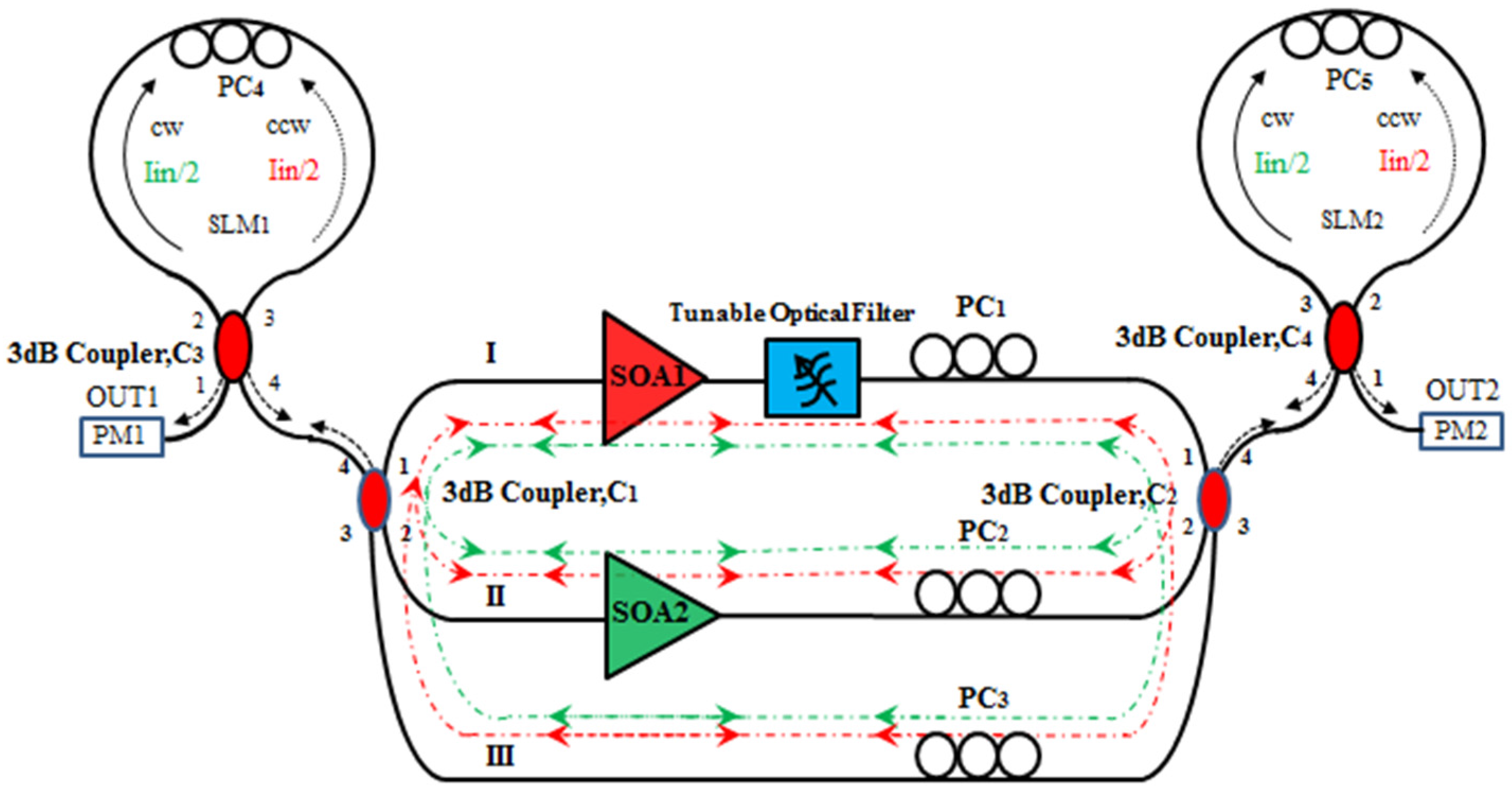
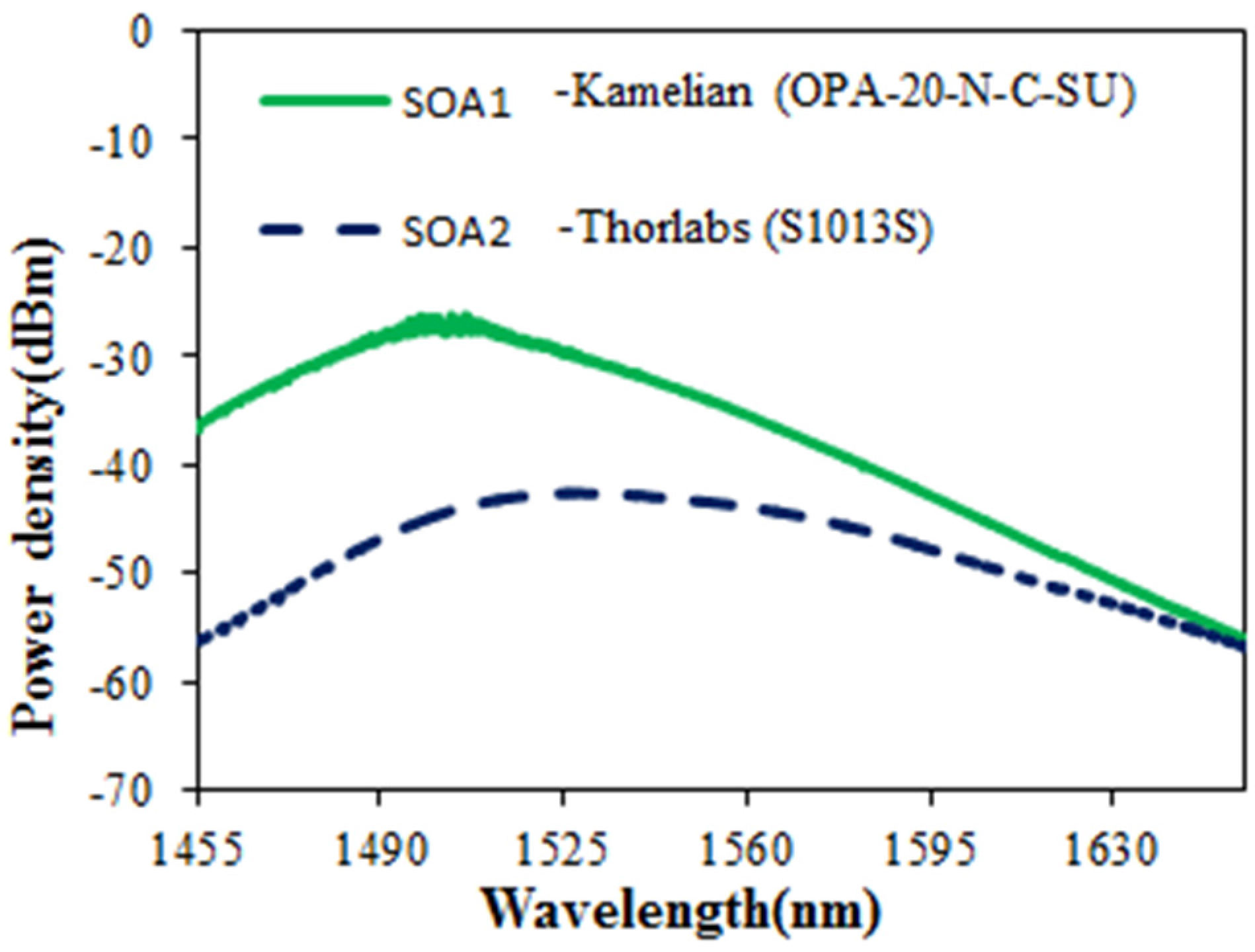
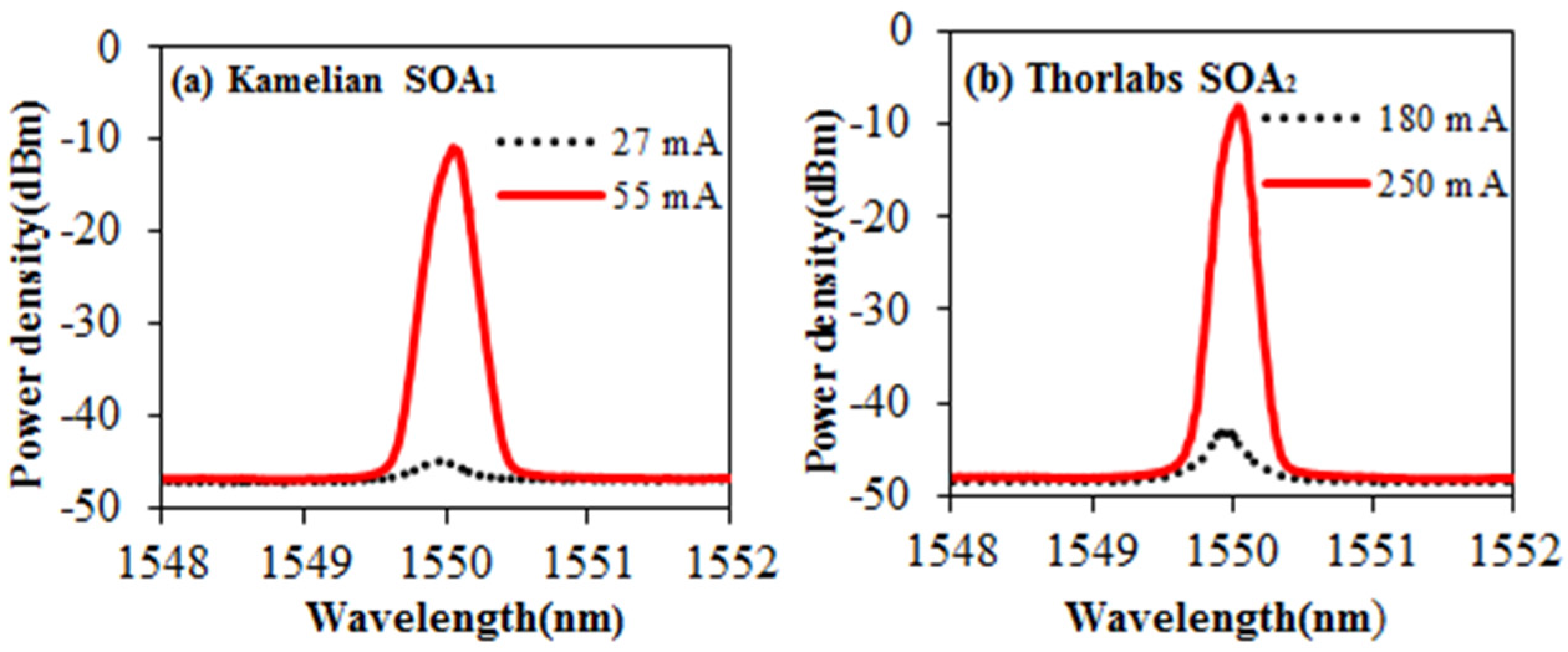
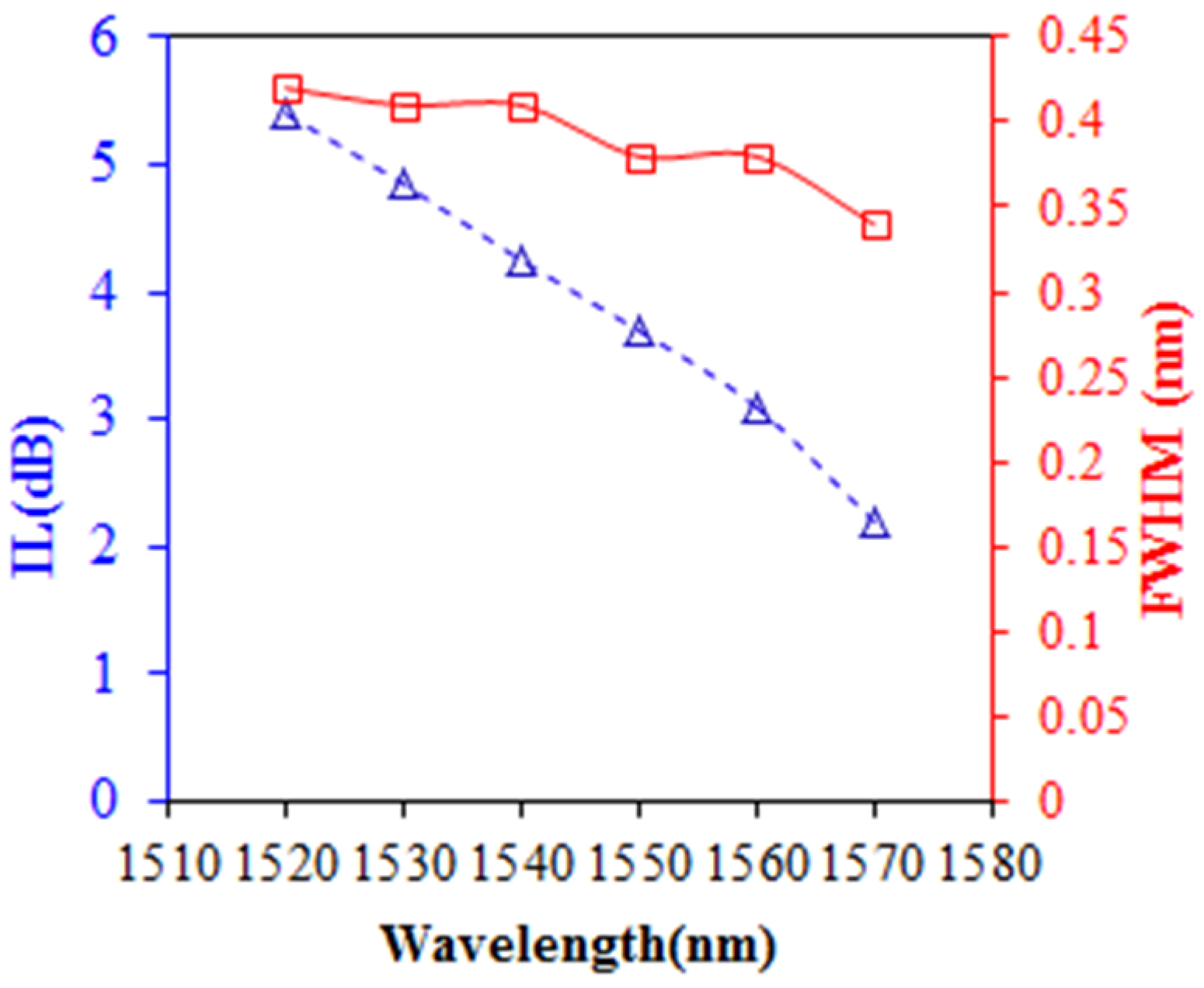


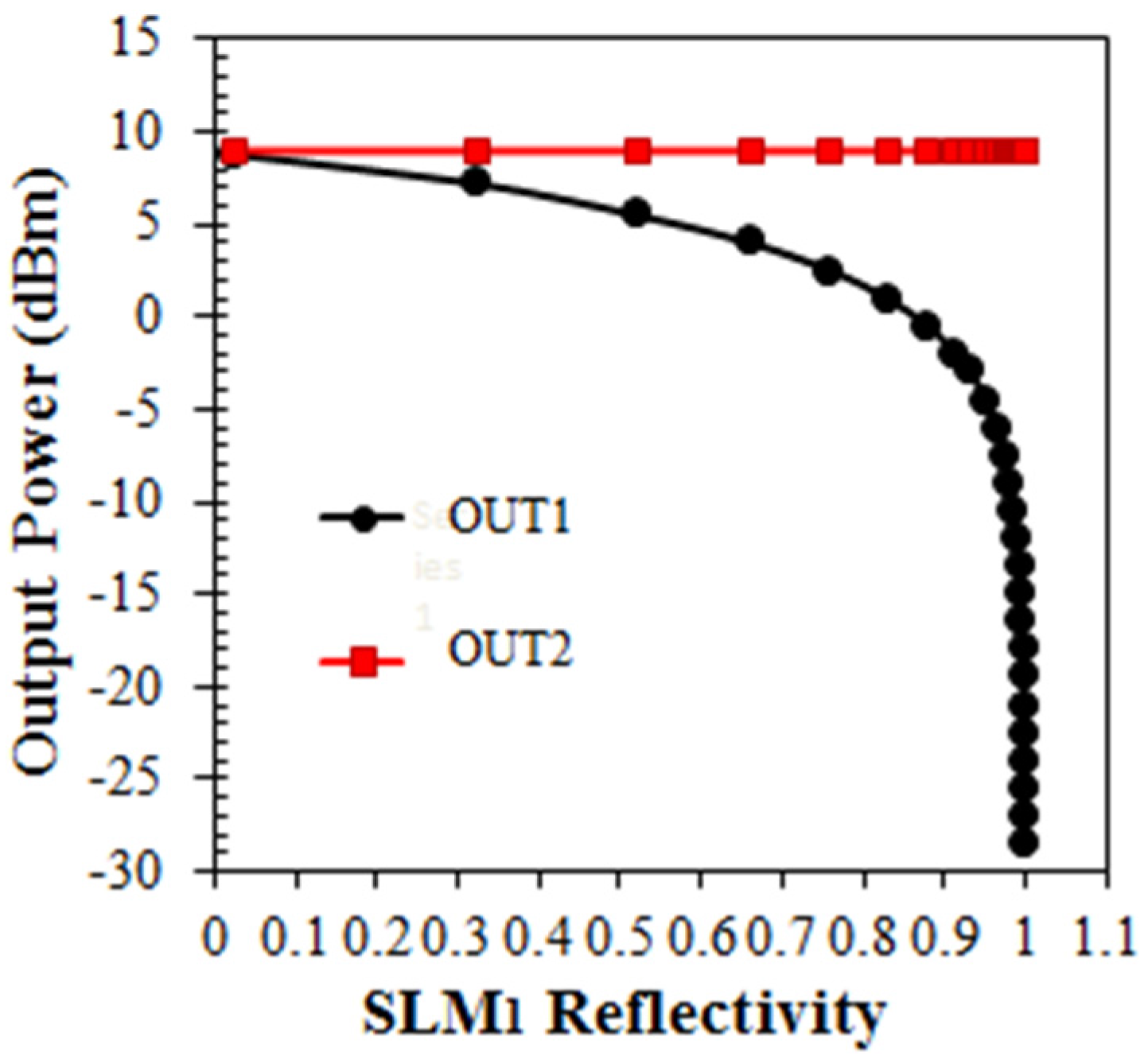
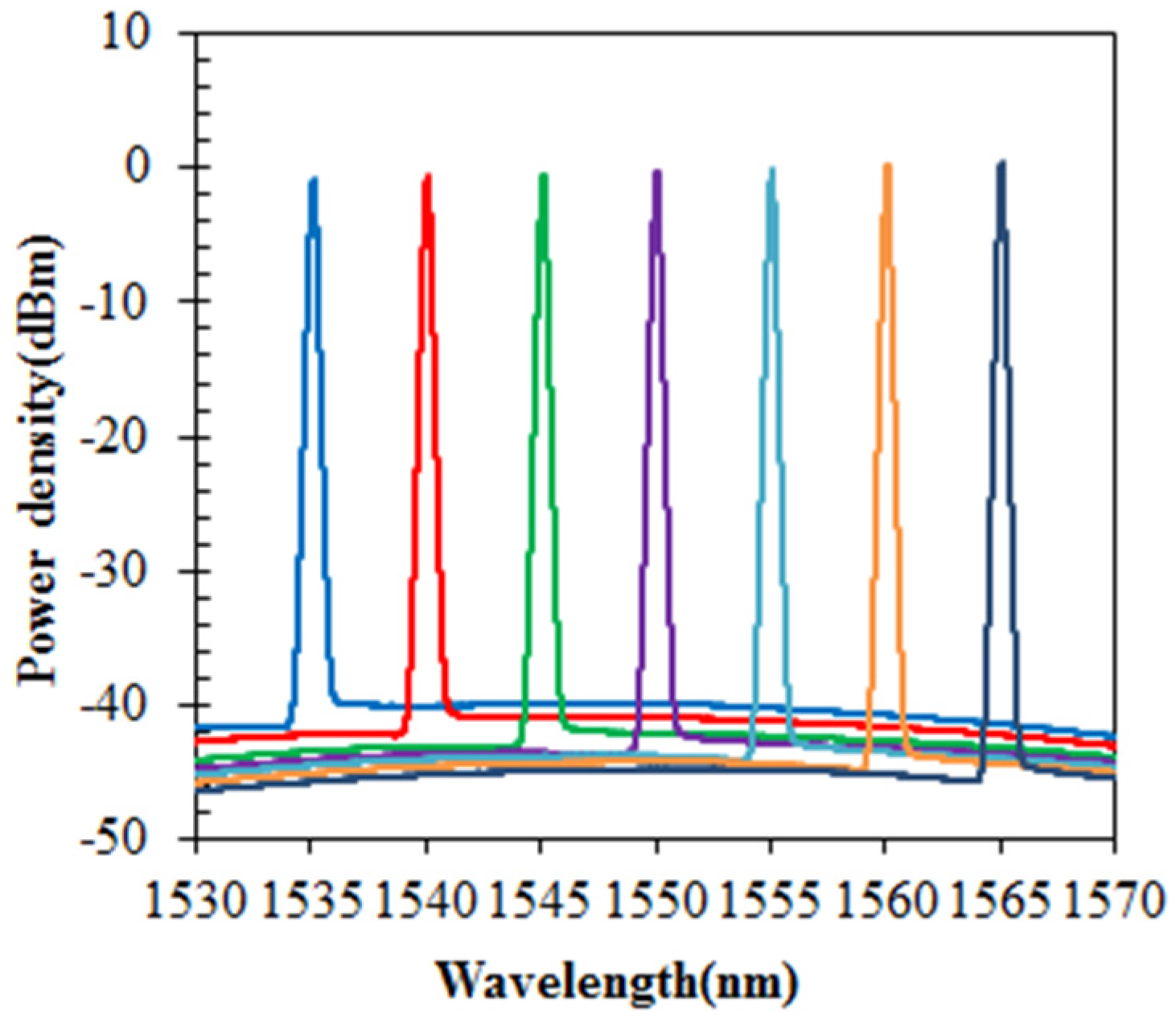
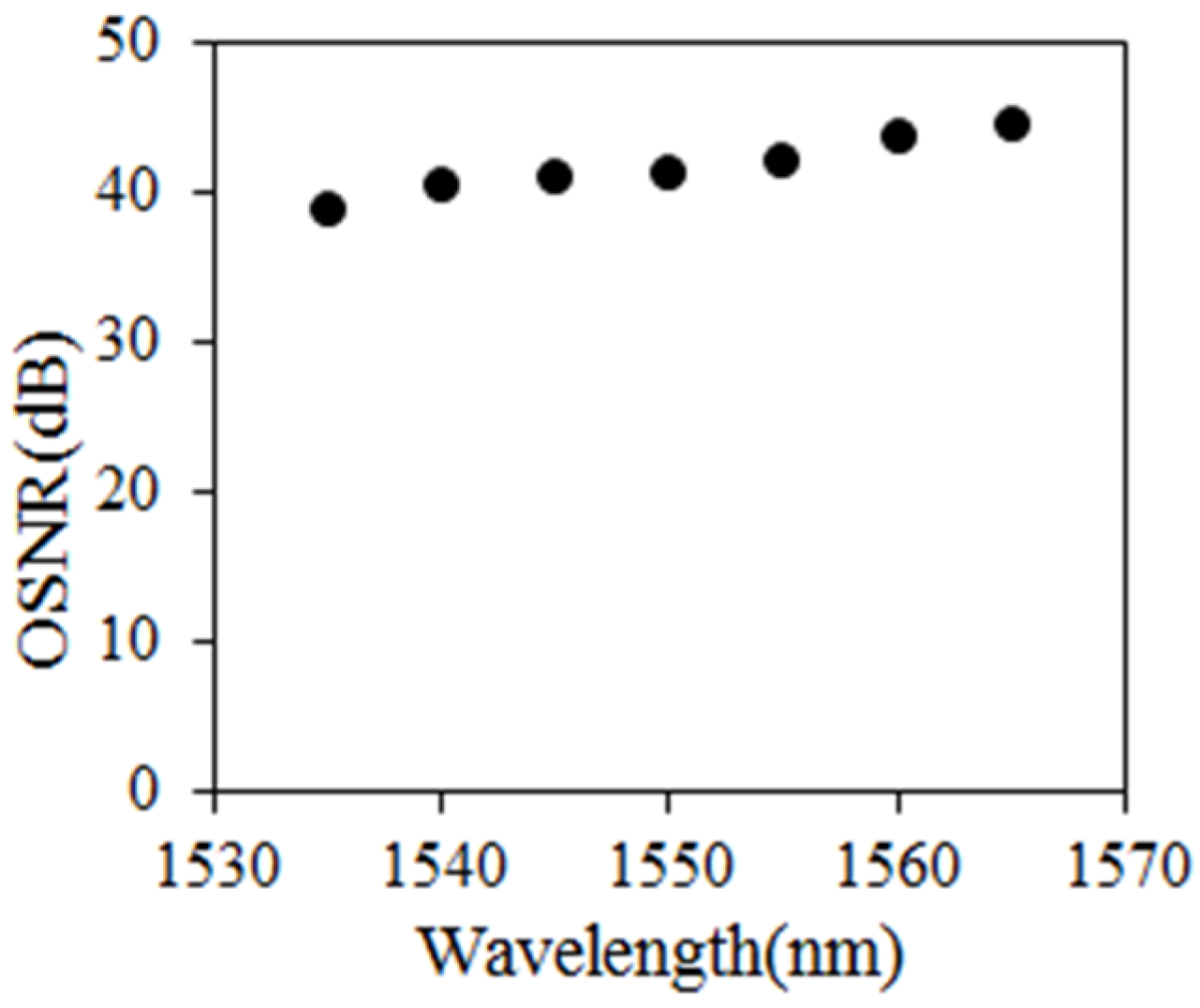
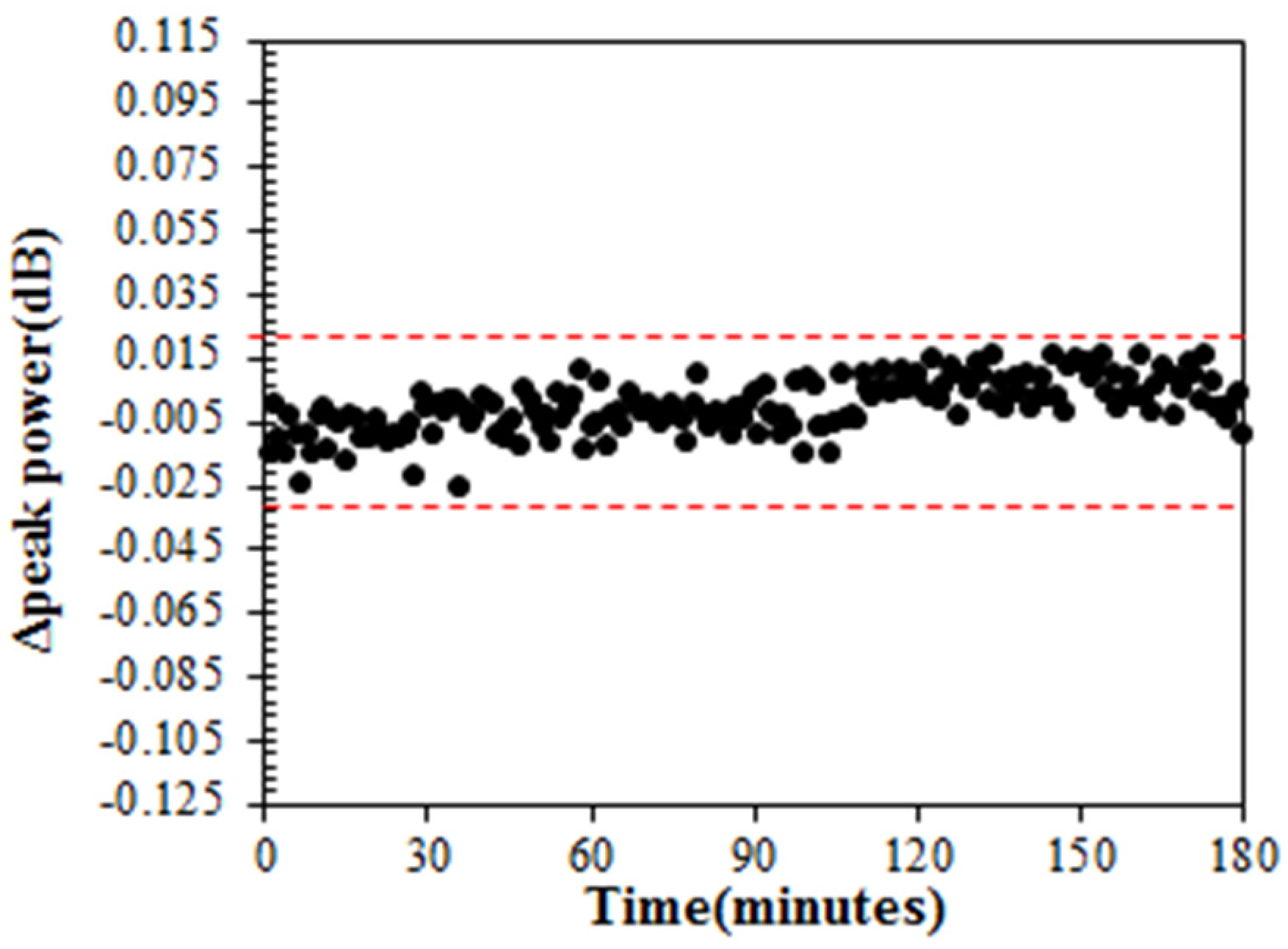
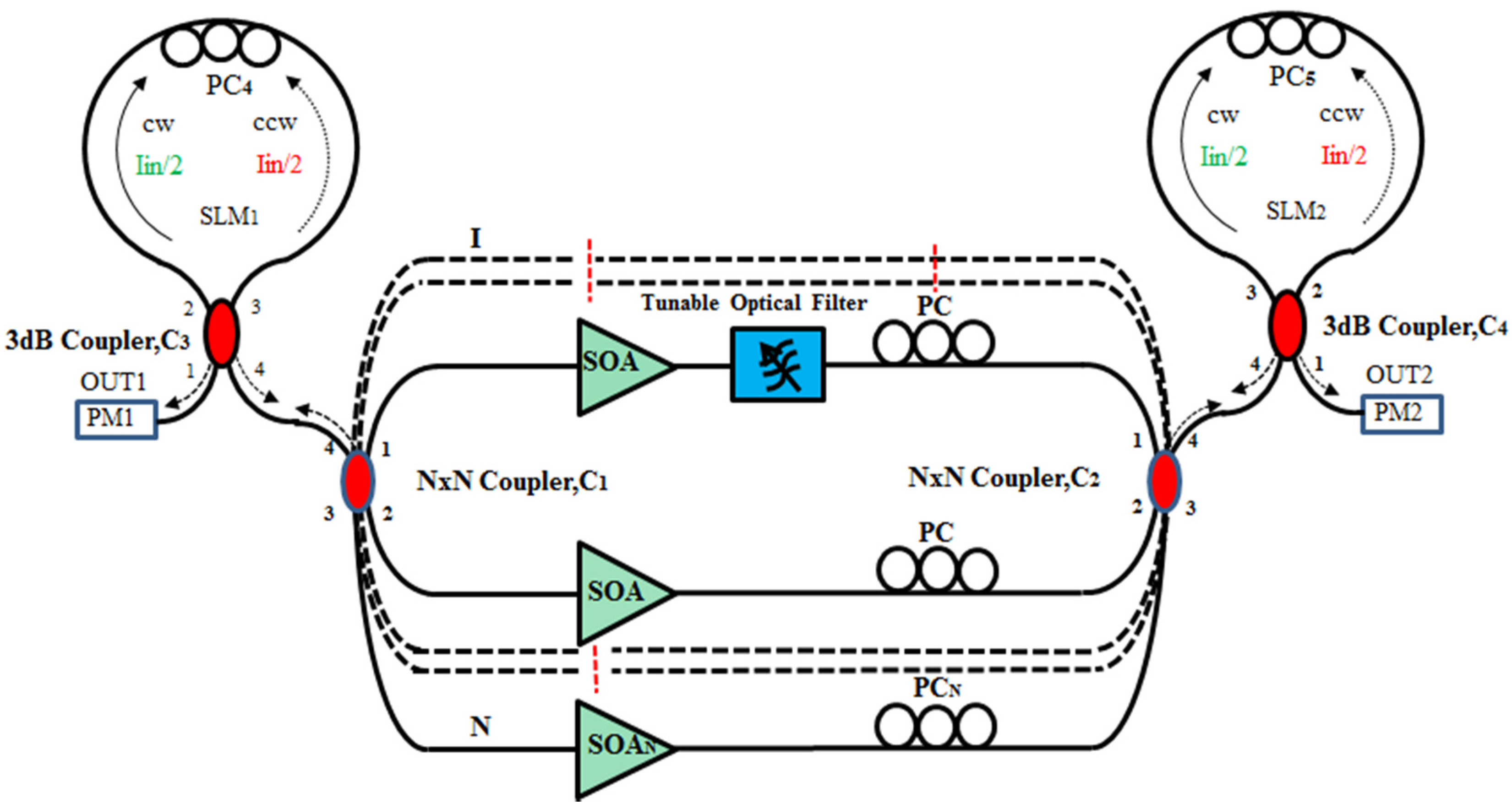
| SOA1 IB1 (mA) | SOA2 IB2 (mA) | POUT1 (dBm) | POUT2 (dBm) | 3 dB-BW (nm) |
|---|---|---|---|---|
| 75 | 250 | 3.40 | 3.40 | 0.1985 |
| 100 | 300 | 5.80 | 5.70 | 0.2075 |
| 125 | 350 | 6.73 | 6.75 | 0.2122 |
| 150 | 400 | 7.65 | 7.68 | 0.2131 |
| 175 | 450 | 8.35 | 8.35 | 0.2157 |
| 200 | 500 | 8.94 | 8.95 | 0.2182 |
| SOA1 IB1 (mA) | SOA2 IB2 (mA) | POUT1 (dBm) | POUT2 (dBm) |
|---|---|---|---|
| 26 | 180 | −36 | −1.5 |
| 50 | 200 | −32 | 5 |
| 75 | 250 | −29.5 | 7.8 |
| 100 | 300 | −28.9 | 9.3 |
| 150 | 400 | −28.6 | 11.1 |
| 200 | 500 | −28.9 | 11.85 |
© 2017 by the authors. Licensee MDPI, Basel, Switzerland. This article is an open access article distributed under the terms and conditions of the Creative Commons Attribution (CC BY) license (http://creativecommons.org/licenses/by/4.0/).
Share and Cite
Ummy, M.A.; Bikorimana, S.; Dorsinville, R. A Novel Technique for Designing High Power Semiconductor Optical Amplifier (SOA)-Based Tunable Fiber Compound-Ring Lasers Using Low Power Optical Components. Appl. Sci. 2017, 7, 478. https://doi.org/10.3390/app7050478
Ummy MA, Bikorimana S, Dorsinville R. A Novel Technique for Designing High Power Semiconductor Optical Amplifier (SOA)-Based Tunable Fiber Compound-Ring Lasers Using Low Power Optical Components. Applied Sciences. 2017; 7(5):478. https://doi.org/10.3390/app7050478
Chicago/Turabian StyleUmmy, Muhammad A., Simeon Bikorimana, and Roger Dorsinville. 2017. "A Novel Technique for Designing High Power Semiconductor Optical Amplifier (SOA)-Based Tunable Fiber Compound-Ring Lasers Using Low Power Optical Components" Applied Sciences 7, no. 5: 478. https://doi.org/10.3390/app7050478
APA StyleUmmy, M. A., Bikorimana, S., & Dorsinville, R. (2017). A Novel Technique for Designing High Power Semiconductor Optical Amplifier (SOA)-Based Tunable Fiber Compound-Ring Lasers Using Low Power Optical Components. Applied Sciences, 7(5), 478. https://doi.org/10.3390/app7050478





